Cast Iron vs Carbon Steel Pans for Cooking
--WHAT IS THE DIFFERENCE BETWEN IRON AND STEEL
What is iron?
Iron is a lustrous and ductile metal with the atomic number 26. It has a chrome-colored appearance that reflects a significant amount of light. Iron is also a ferromagnetic metal, meaning it's magnetic and attracts other ferromagnetic metals.
ron (/?a??rn/) is a chemical element with symbol Fe (from Latin: ferrum) and atomic number 26. It is a metal that belongs to the first transition series and group 8 of the periodic table. It is, by mass, the most common element on Earth, right in front of oxygen (32.1% and 30.1%, respectively), forming much of Earth's outer and inner core. It is the fourth most common element in the Earth's crust.
What is Steel?
Steel is an alloy made up of iron with typically a few tenths of a percent of carbon to improve its strength and fracture resistance compared to other forms of iron. Many other elements may be present or added. Stainless steels that are corrosion- and oxidation-resistant need typically an additional 11% chromium.
What is Cast Iron?
Cast iron is a group of iron–carbon alloys with a carbon content more than 2% ((typically 2.0–4.3 percent). Its usefulness derives from its relatively low melting temperature. The alloy constituents affect its colour when fractured: white cast iron has carbide impurities which allow cracks to pass straight through, grey cast iron has graphite flakes which deflect a passing crack and initiate countless new cracks as the material breaks, and ductile cast iron has spherical graphite "nodules" which stop the crack from further progressing. Carbon (C), ranging from 1.8 to 4 wt%, and silicon (Si), 1–3 wt%, are the main alloying elements of cast iron. Iron alloys with lower carbon content are known as steel
The higher carbon content of cast iron pans gives it a rough, slightly bumpy feel.
What is Carbon Steel?
Carbon steel is a steel with carbon content from about 0.05 up to 2.1 percent by weight.
Carbon steel is a special type of steel that, as the name suggests, has a higher concentration of carbon than other types of steel. Most types of steel have a relatively low carbon content of about 0.05% to 0.3%. In comparison, carbon steel has a carbon content of up to 2.5%. Two-and-a-half percent carbon may sound insignificant, but it introduces several attractive benefits that aren't found elsewhere.
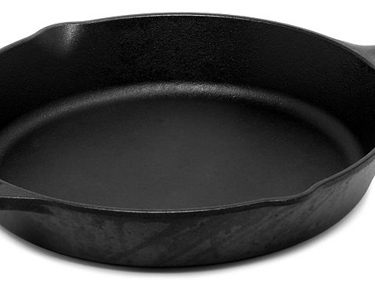 |
Cast Iron Pan (Lodge) after full seasoning |
ADVANTAGES AND DISADVANTAGES OF CAST IRON COOKING
Cast Iron Skillet Advantages:
-- a properly seasoned cast iron pan is nonstick
-- excellent conductor of heat -- heats evenly
-- very cheap to buy
-- one of the best pans to use to sauté a steak
--It is a good regulator. It retains its temperature longer than other materials and won’t produce temperature spikes.
-- Cast iron has unparalleled searing power because it has a lot of available thermal energy.
Cast Iron Skillet Disadvantages:
-- a properly seasoned cast iron pan is nonstick
-- cast iron pans are heavy and difficult to use in some sauté procedures
-- if not properly cared for a cast iron pan will rust
-- Cast iron is slow to heat up, so it’s also slow to cool down.
--Not recommended for deglazing using acids or wine.
ADVANTAGES AND DISADVANTAGES OF CARBON STEEL
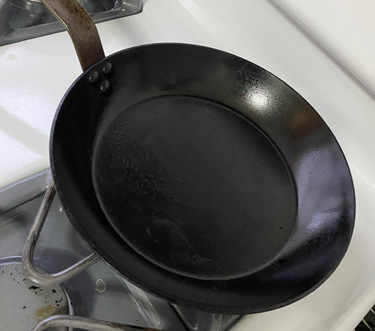 |
CARBON STEEL PAN
de Buyer Carbon Steel seasoned (1% carbon, 99% iron) |
Carbon Steel Skillet Advantages:
-- lighter weight and easier to use than cast iron pans
-- carbon steel is more versatile --it is safe to use on the stove, in the oven, under the broiler, and on the grill.
-- It heats up fast like stainless steel, it can tolerate high heat like cast iron, and is naturally non-stick.
--it's more conductive than cast iron, it heats more evenly, with fewer hot spots.
from madein
Carbon steel cookware is lightweight, hard-wearing, and conducts heat faster and more evenly than pretty much any other similar material. It's more versatile and easier to maneuver than cast iron, and way more durable than stainless steel, copper and regular
Carbon Steel Skillet Disadvantages:
--more expensive than cast iron
--Carbon steel cookware doesn't heat as evenly as stainless steel,
-- it requires seasoning, it's susceptible to rust, and it reacts to acidic food.
NOTE: While cast iron is slow to heat up, carbon steel pans reach the ideal cooking temperature quickly. ... Cast iron cookware is slow to heat up, but retains heat longer than carbon steel. This makes cast iron ideal for pan-frying and roasting.
NOTE:Cast iron skillets do not heat evenly on the stove top so for best results preheat the pan in the oven then cook on top. This will insure a nice even sear. In some case e.g., a rib eye steak, chicken legs or pork chops we will return to the oven to get a nice even crisp brown (see photo below). ast iron skillet with wine since the acid can react with iron. But it's OK to deglaze with a stock.
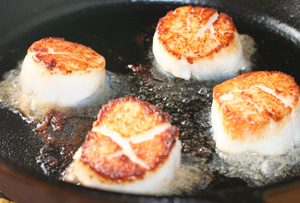 |
SEARED SCALLOPS -- YOU CAN'T GET BETTER SEARS FOR SCALLOPS THAN IN CAST IRON SKILLET Cast Iron Cooking -- Seared Scallops in preheated hot cast iron skillet... 3 minutes on heat, flip, turn off heat and remove from hot burner. The pan is hot so it will continue to cook through. |
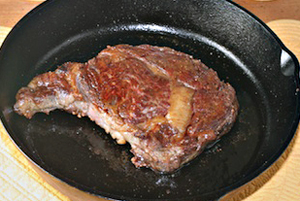 |
RIB EYE STEAK Cast Iron Cooking--this is probably one of the best ways to do a rib eye steak. Let the steak come to room temperature... salt and pepper and a little oil on both sides. Heat the skillet at 475 in the oven then bring to the stove top and heat some more (dry). Then throw it 3-5 minutes on each side and another 5 minutes in the oven. This gave a nice medium rare center after resting another 5 minutes off the skillet. This was a 1.05 lb, 1inch thick cut. You will have to play with the times using this method to get it right to your taste --- just remember to expect a 'lot' of smoke on the stove top! |
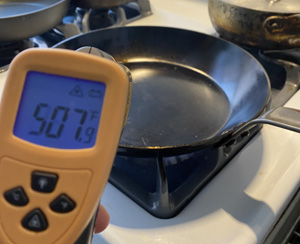 |
|
See also
Science of Cast Iron Skillet Cooking --WHEN TO USE A CAST IRON SKILLET AND HOW TO KEEP THEM SEASONED